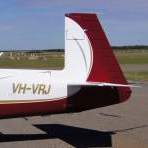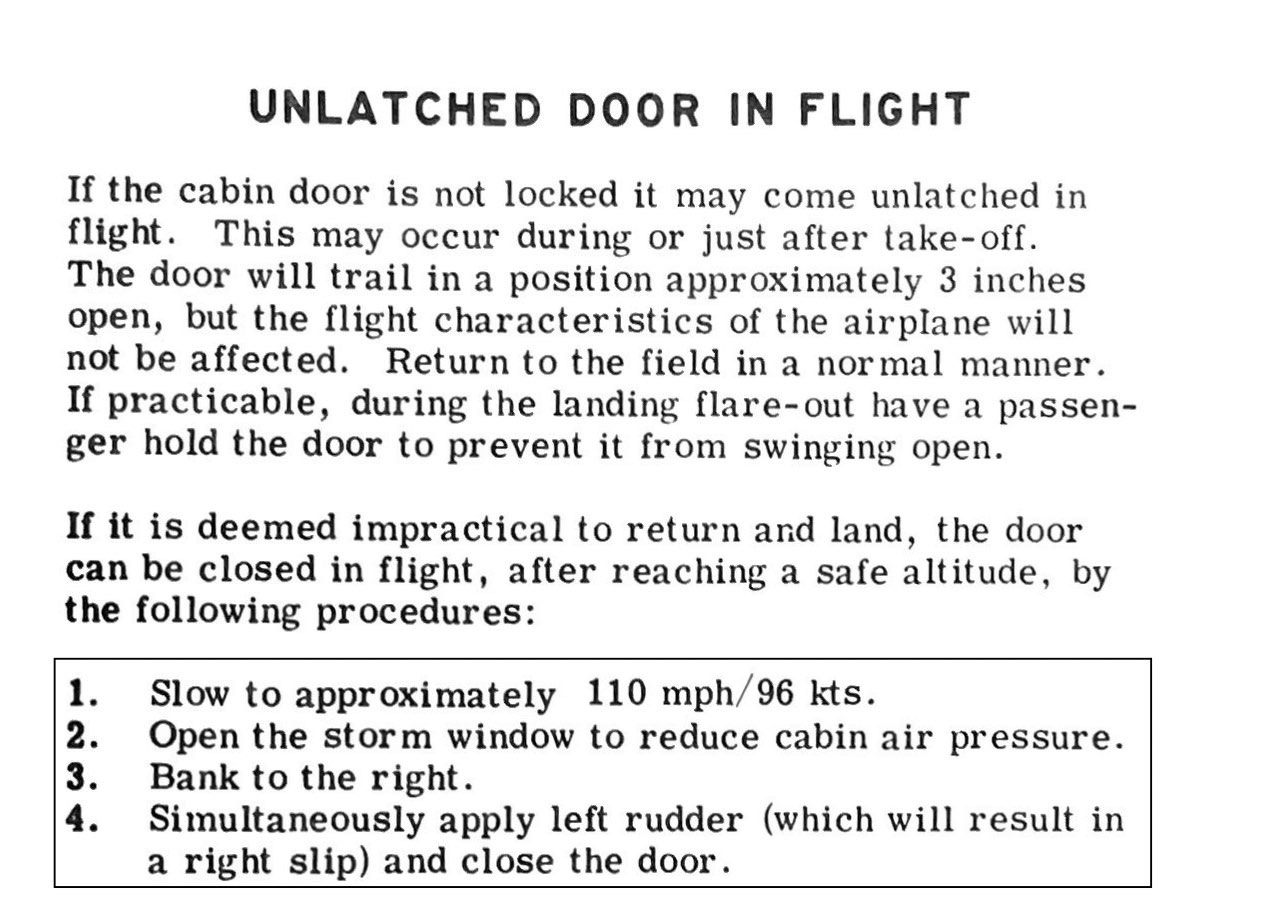-
Posts
722 -
Joined
-
Last visited
Content Type
Profiles
Forums
Blogs
Gallery
Downloads
Media Demo
Events
Everything posted by Mooney in Oz
-
Thanks Oscar. It must have been very distracting. A good decision to just fly the aircraft in those conditions.
-
Hello Oscar. I'm somewhat late to the party, but first of all I just want to say, very well done! Your video should be used at Mooney and other types pilot proficiency course ground schools as an example of keeping one's cool following an abnormal occurrence and ending in a better than normal landing. Can I just confirm one thing and that is your door opened fully in flight? I may have misunderstood and I'm certainly not doubting you, but the reason I ask is I have never heard of the entry door fully opening in flight before in a Mooney. I have attached a copy of the Unlatched Door In Flight checklist out of the J POH Emergency Procedures section. It has been years since the same happened to me twice in cruise after the interior was renovated. I did what the checklist says and other than an annoyance, it was a non event. If it occurred just after takeoff or close to the destination, I would have done what you did.
-
G'day Clarence. The same happens to me only on very hot summer days sporadically when I attempt to shut down after landing. Is this likely to be the same cause? IO360A3B6D
-

Dream Plane but not a Mooney
Mooney in Oz replied to Canadian Gal's topic in Miscellaneous Aviation Talk
Plus the fact the Aerostar was manufactured by Mooney under licence for a period of time. -

Accident near HPN
Mooney in Oz replied to BravoWhiskey's topic in Mooney Safety & Accident Discussion
I also listened to the recording and the pilot did say he lost a cylinder. I imagine that alone would have caused a fair degree of airframe vibration and added further stress to the pilot. The controller missed the pilot’s emergency declaration because of frequency congestion. He did such a brilliant job . -
Thank you Don. Very helpful as always. Please pass on my regards to Shirley.
-
G'day Don. Do you recommend the same for a J?
-

Accident near HPN
Mooney in Oz replied to BravoWhiskey's topic in Mooney Safety & Accident Discussion
The A36 is fitted with a Continental fuel injected engine, so no carb ice. According to the link, the pilot reported loss of oil pressure to ATC. This plus possible airframe ice and a reported 200 foot base would not have given the pilot much time to see the runway. It must have been a frightening ordeal. May they both RIP. -

Century IIb not following new IFD 440 in NAV mode
Mooney in Oz replied to Bartman's topic in Avionics/Panel Discussion
My previous autopilot was a 55X and it worked well with both my IFD 540 & 440. -
The easiest way to enter maintenance mode is before powering the unit, place a USB stick into the side USB slot, the same as you do when intending to update Nav data. Power up the unit and it will go into maintenance mode as it detects the stick. Along the bottom you will see a single row of about 5 tabs of which the first is 'Update' for Nav or other data and the last should be 'Config'. Tap the Config tab and then you will go straight into the Config pages of which there are about 14. Scroll the right outer and inner knobs to select pages and highlight items. Push on the knob to edit. If you encounter problems either call or contact tech support via the support page https://pilotsupport.avidyne.com/new or email tech support (techsupport@avidyne.com). They are very helpful and respond reasonably quick using either their support page or email.
-
G’day Fred. About the last week of November 2021, Avidyne released 10.3.0.2 update and it is free. There has been a fair amount of complaints relating to a number software bugs. As Lance suggested, have a look at the Avidyne Live forum and enter 10.3 into the search function. You will see what I mean. A number of posters have reverted their units back to 10.2. I had 10.3 installed and actually find it to be quite good. The most obvious and annoying bug is each time the unit is restarted, the comms default to KMLB frequencies, which is the location of the Avidyne factory. Avidyne are actively working on a software release to get rid of the bugs, so you may want to wait until the software is released. For further info, the URL for Avidyne Live is http://forums.avidyne.com/forums.html It is worthwhile to register and be kept up to date with the latest info. You can also participate, as you do here. The forum is monitored by an Avidyne software engineer (AviSteve) who chimes in to answer questions.
-

Does The Mooney Wing Tank Hide Water?
Mooney in Oz replied to GeeBee's topic in Mooney Safety & Accident Discussion
I’ve had the same setup for about the past 15 years. Prior to that each vent had a very small screen covering the outlet until they somehow disappeared. -

Does The Mooney Wing Tank Hide Water?
Mooney in Oz replied to GeeBee's topic in Mooney Safety & Accident Discussion
I just ordered a pair. Thanks for the suggestion. -

Does The Mooney Wing Tank Hide Water?
Mooney in Oz replied to GeeBee's topic in Mooney Safety & Accident Discussion
What is a SS fuel neck? -
You also won’t have to worry about the engine stopping if you forget to close the ram air when inadvertently entering icing conditions. Ask me how I discovered this . Ram air removed thereafter.
-
Beware of marketing speed claims.
-

Avidyne 540- updating NAV data
Mooney in Oz replied to 0TreeLemur's topic in Avionics/Panel Discussion
Make sure the 'N' number displayed in the IFD config settings is exactly the same as your tail 'N' number. Agree with Lance that you need your own Jepp account. -
You would be forgiven for thinking so. The latest G3X Touch Certified PG still has an illustration of a flap position and rudder trim indicator on the bottom left of the PFD on the GDU 460. This is not permitted in the certified world and therefore has no relevance to certified aircraft. It simply looks like a cut and paste job from the experimental PG. Who at Garmin checks these things before PG release?
-
Happy New Year to y’all from Australia
-

Static wicks what benefit do they serve?
Mooney in Oz replied to Will.iam's topic in Modern Mooney Discussion
It is probably a phenomenon that rarely happens and it only happened once to me, which was one too many times as I literally had no comms, only static and why I decided to have the wicks fitted. The phenomenon nicknamed St. Elmos Fire that Skip alluded to in his above post (I recall flying my '78 J through heavy rain one dark (and stormy - sorry, couldn't resist) night and I could put my finger on the windshield and cause an eerie corona discharge that didn't seem to affect the VHF navs or comms.), can result in a striking blue streak surrounding and travelling down the windshield is also static electricity. This is also a rarity that I have seen at night maybe 3 or 4 times in 3,400 hours of night flying, so environmental conditions have to be ripe and why it is so rare. I think Paul this maybe the same reason you have not experienced radio static. Despite the nickname, St. Elmos Fire is not dangerous, but if you touch it, it could give you a very light static shock, similar to touching a door handle after walking across a carpet covered floor in shoes caused by friction between the soles and carpet. -

Static wicks what benefit do they serve?
Mooney in Oz replied to Will.iam's topic in Modern Mooney Discussion
Years ago while flying through rain and cloud, my comm had so much intermittent static noise that I could barely decipher radio transmissions. My aircraft engineer recommended static wicks, so I had them fitted. Never a problem with static noise since. Later I was told by someone that the wicks are only useful for aircraft that fly at a TAS greater than 200 knots. Contrary to this info, mine work well. No, it doesn’t. -

Any new on GFC500 SB ?
Mooney in Oz replied to Philip France 13's topic in Avionics/Panel Discussion
Just checked the Garmin Support (Service Bulletin) web page. At this stage no software fix for certified aircraft has been issued, although a software fix for the experimental crowd was released almost 3 weeks ago. I assume Garmin is waiting for FAA approval. Any time you want to check for yourself, the URL is: https://support.garmin.com/en-US/?faq=6uYPdAQOaS9FzhhL5yaOf -

CIRRUS DOWN AT KMYF TODAY
Mooney in Oz replied to DCarlton's topic in Mooney Safety & Accident Discussion
Good point and I too wondered about that. Another MSer (who I can’t recall) posted and explained well the difference between the auto trim system in Cirrus aircraft and other aircraft that are subject to this SA. @DCarlton I found the post but it was not on MS. If you want to read the thread in its entirety, it was on Beechtalk in the ‘Panel Talk’ section and posted by ‘Garmin Aviation Team’ under the thread, ‘Alert Garmin GFC 500 autopilot for Certified and Experimental’ and is actually the first post on page 1 of 6. The post is quite long and reads in part, “The Cirrus SR 20 and Cirrus SR 22 aircraft are not affected. They use the original manufacturers’ pitch trim cartridge to move the pitch trim at slower speeds than the GSA 28 pitch servo.” -

CIRRUS DOWN AT KMYF TODAY
Mooney in Oz replied to DCarlton's topic in Mooney Safety & Accident Discussion
As per the Garmin Service Alert, Cirrus aircraft are not affected. https://atlaske-content.garmin.com/filestorage//email/outbound/attachments/22109A_Time1669064630332.pdf





